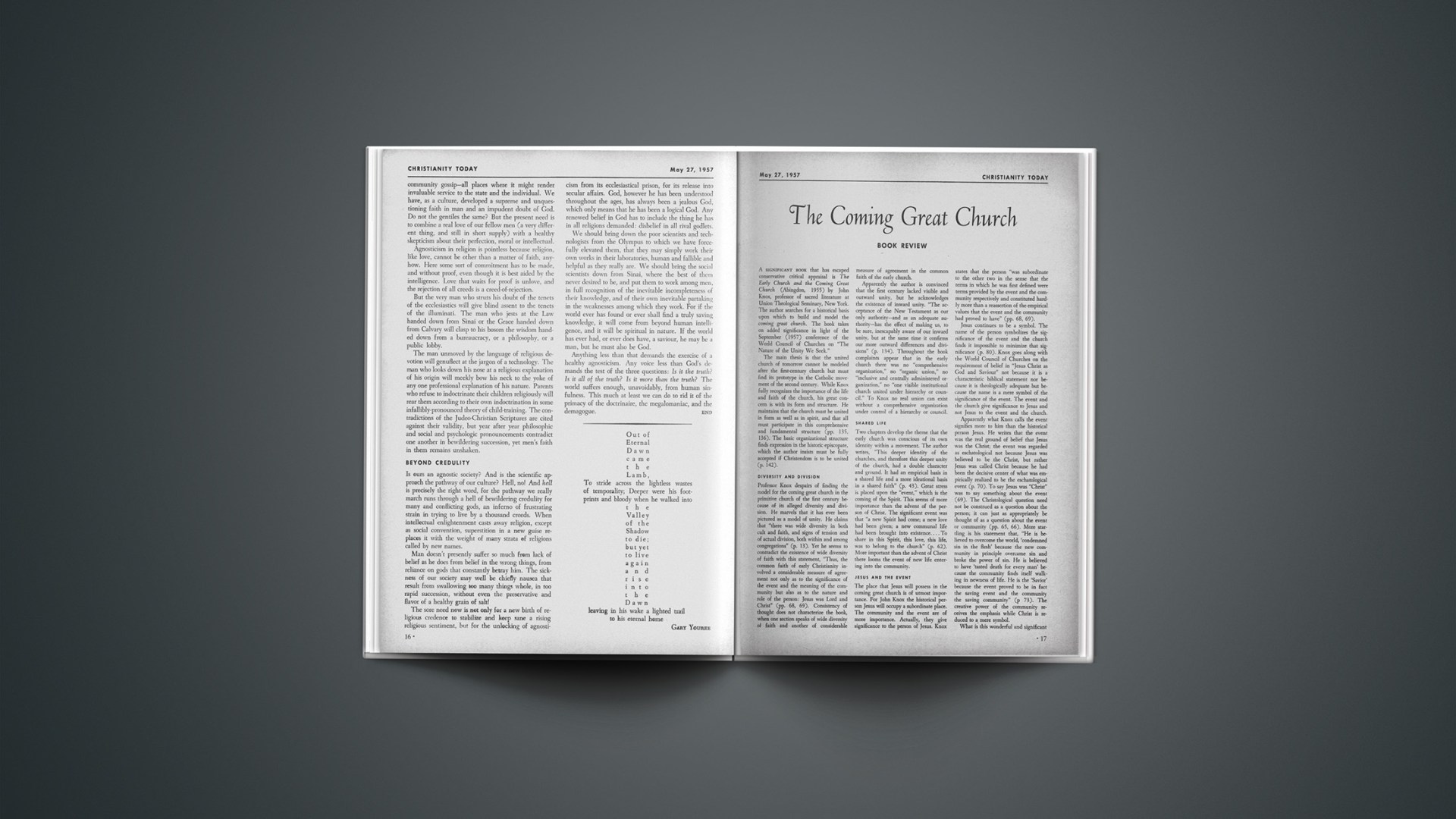The name of Count Nicolaus Ludwig Von Zinzendorf has come down in church history as the instrument which the Holy Spirit used to spark one of the greatest revivals the world has ever seen. Through his efforts prayer meetings started that continued for a hundred years. There were many evidences of a signal working of the Holy Spirit, and this Moravian revival originating in Germany began to affect distant parts of the world. Strange to say, however, although these basic facts are generally known, few theologians know what actually sparked this revival. Nor is it generally realized in circles of Christian leadership that the discovery of Zinzendorf’s secret might lead to similar spiritual repercussions today.
A Class Of Nine Girls
It was August 17, 1727. Count Zinzendorf was giving spiritual instruction. Was this to a church of a thousand wealthy and influential adherents? Far from it! The Count’s occupation would be disdained by many of today’s clergy. His instruction was to a class of nine girls between the ages of ten and thirteen. He had told his wife that although the girls gave outward attention, he could not perceive any traces of spiritual life among them. It is recorded that on July 16 he poured out his heart in effective prayer, and was in great anguish of soul for these girls. Then for ten days, August 17 to 27, this influential Count’s prayers were answered in a great outpouring of the Spirit of God upon these girls. As the hours passed, more girls, then the boys, then the adults of the refugee community of Herrnhut came under the Spirit’s influence. An eyewitness said, “I cannot ascribe the cause of the great awakening of the children of Herrnhut to anything but the wonderful outpourings of the Spirit of God.…”
Where God Begins
An exhaustive study of this great spiritual movement was made by Dr. Clay Trumbull, who in his Yale Lectures states that Zinzendorf and his co-workers took up an emphatic ministry among the children. They preached directly to them, gathering large numbers into the church fold. At the same time they arranged for the personal training of the converts individually by placing them in small classes under special teachers. John Wesley met Zinzendorf and went away persuaded that children can play a great part in any spiritual movement. Thus Wesley laid great stress on the work among the children and on the class instruction of converts. He said, “Unless we take care of the rising generation the present revival of religion will be res unius actatis—it will only last the age of a man.” And Dr. Trumbull stresses that in this statement Wesley touched the truth of truths concerning God’s method of giving permanent power to the work of his church. Lecky, in his careful review of the methods and influence of the Wesleyan movement, says, “The Methodists appear to have preached especially to children”; and he cites the words of Wesley when describing “among other cases, a remarkable revival among children at Stockton-upon-tees in 1784. Is this not a new thing upon earth? God begins his work in children.… Thus the flame spreads to those of riper years.”
Similar Pattern Of Events
Today in America and elsewhere there appears to be a condition much the same as the spiritual condition prior to the above mentioned revivals. There is also much evidence that the Holy Spirit is working in an unusual way among children. The need of today is for influential Zinzendorfs and fiery Wesleys to pour out their hearts for the children. The enemy of souls seems to be subtly busy doing all he can to keep our attention, our praying, our budgeting, our planning, on adult evangelistic crusades, because as Billy Sunday said, it is a miracle of God if a man over forty comes to him. We no longer remember that Moody and Spurgeon started their tremendous ministries among children, that Dr. Torrey said, “It is a well proven fact that no other kind of meetings bring such definite results in the way of conversions as meetings held for the specific purpose of bringing children to Christ. No revival is what it ought to be if a great deal of attention is not given to the children, and much prayerful effort put forward for their conversion. Whatever other meetings are held or omitted in times of special revival interest, meetings for children should not be omitted under any circumstance.”
God’S Heart For The Child
The above quotations are but from men, and some may question their authority. How wonderful, then, to find that they agree with Scripture. God’s heart is very tender toward the child. It is not his will that one of these little ones should perish. Christ commands us to suffer them to come to him. He promises reward to those who minister to the child. He also informs us that they have angels that appear before his face! Christ himself warns us not to “think down upon” (Young) one of these little ones, and his denunciation of anyone who would cause a child to stumble is indeed serious. It brings to mind the minister who gave an altar call and found his own six-year-old among the penitents. “Run along home,” he whispered, “this is no place for you.” But upon the father’s homecoming he found he had offended his little one as he heard his plaintive, “I wanted to come to Jesus but Daddy wouldn’t let me.” As father and son knelt together, a child’s angel appeared before the Father in heaven with the news that caused rejoicing among the angels, and a minister of the gospel found forgiveness for the tremendous transgression of “forbidding” a child.
Neglect Of The Young
Scripturally, historically, statistically, there is ample evidence that spiritual attention should be given to children in an aggressive and positive way. Too many churches are leaving the care of the children to the church school; hence we find but 20 per cent of the scholars converted and 80 per cent or more leaving in their teens. The church school has its important place; yet these spiritual statistics but emphasize Finney’s statement that the church does not advance by its routine program but by special spiritual efforts and “there will never be a revival till somebody makes particular efforts for this end.…” Such special efforts were not uncommon years ago, efforts in which hundreds or thousands of children were brought into evangelistic meetings specially adapted to the child. Space forbids mention of many such recorded campaigns, but an outstanding example is that of Spurgeon’s Metropolitan Tabernacle.
The children’s evangelist was the Rev. E. Payson Hammond, and his book Early Conversions gives much insight into God’s workings among children. Of this campaign Deacon Olney said, “This building will seat six thousand adults, but there are today crowded into it no less than eight thousand.… I believe at least three thousand outside who came here to get admittance cannot do so.” A man of much experience said he believed that during those weeks’ meetings from two to three thousand were convicted of sin and brought to Christ.
When Mr. Hammond returned to London seventeen years after this children’s evangelistic effort, Mr. Spurgeon told him of the permanent result of those meetings. He thanked God for the great numbers that came into the church through the meetings, and told of many preaching the gospel then who had been converted in those meetings. Today it seems that one of our difficulties is that we have lost our belief in the conversion of children, and the church is suffering. Mr. Spurgeon once said that he was in the habit of receiving thirty to forty children into his church every year. He had “found it necessary to excommunicate one or two adults in that time, but had never yet found it necessary to dismiss one received in the early years of childhood.” In America, Payson Hammond had results similar to those in Britain. In one case from a united effort in Rochester 1,001 children joined the churches. Among these were some as young as nine years. Later Dr. Campbell wrote: “Six years ago Mr. Hammond held a similar series of meetings in this city and it is sometimes asked ‘What has become of the converts?’.… At the Central Church a careful investigation has been made.… As the fruit of the revival season of 1863 one hundred and sixty-three persons were received into Central Church.… Of these one hundred and fifty-three are either in good standing today or have taken a regular dismission to other churches, or have died in hope.… Of the 163 new recruits only ten missing at the end of six years.”
Evangelism Versus Entertainment
To get results like the above today we must alter our thinking. We must abandon the thought that child efforts must be addressed by a professional entertainer able to send the child into hysterics. It is time we realized that the child needs the same sane presentation of the passion of Christ that reaches the adult. We have got to look upon the child effort in exactly the same light as the adult effort, except that advertising and program are geared to the child. The adult campaign necessitates the seven P’s, and these must characterize the child effort. Unless Planning, Prayer, Preparation, Publicity, Program, Personal work and Pastoral work are conducted with the same enthusiasm and effort as for the adult campaign, we cannot expect God to fully bless.
But when these conditions are met the results are phenomenal today in America. The harvest field is thirty million unchurched children. It is a virgin mission field on our doorstep. These children are susceptible to gospel influence, but are passing into adulthood and into the sophisticated age at the astonishing rate of fifty thousand a week. The call of God is that Christian leaders face the challenge—and act.
Alongside his work as an electrical engineer, Lionel A. Hunt has carried on children’s evangelistic rallies for more than 20 years. Born in London, he completed studies as a professional engineer in British Columbia in 1932, and now resides in Toronto. He is author of Fruitful Child Evangelism.












